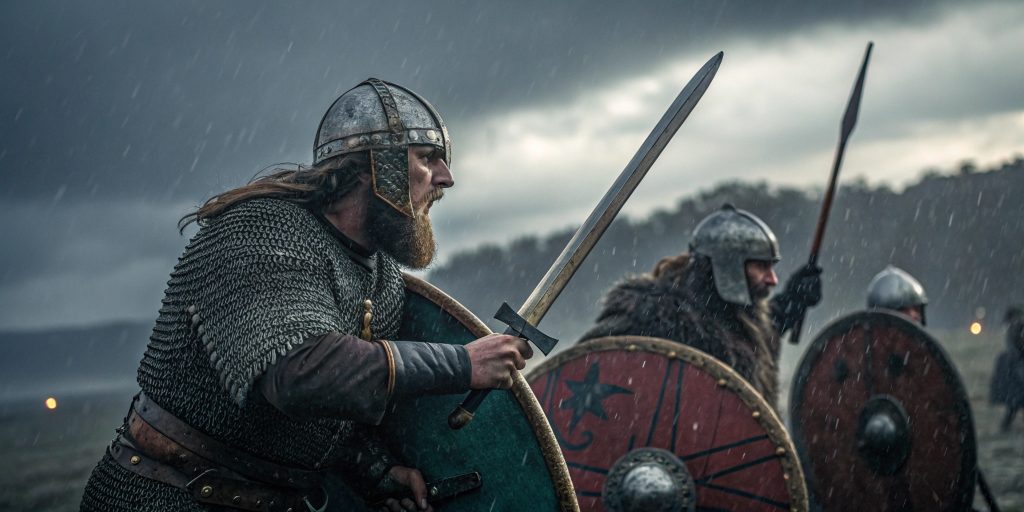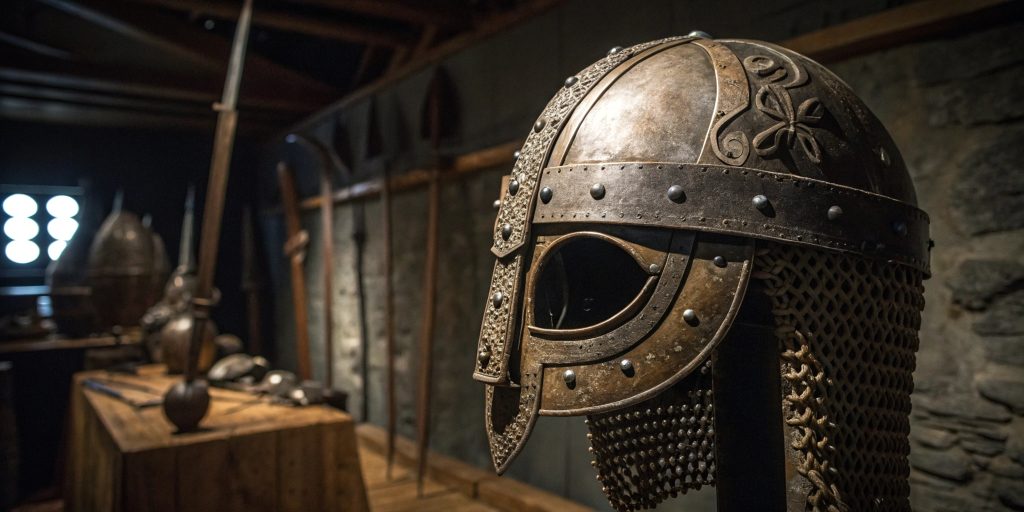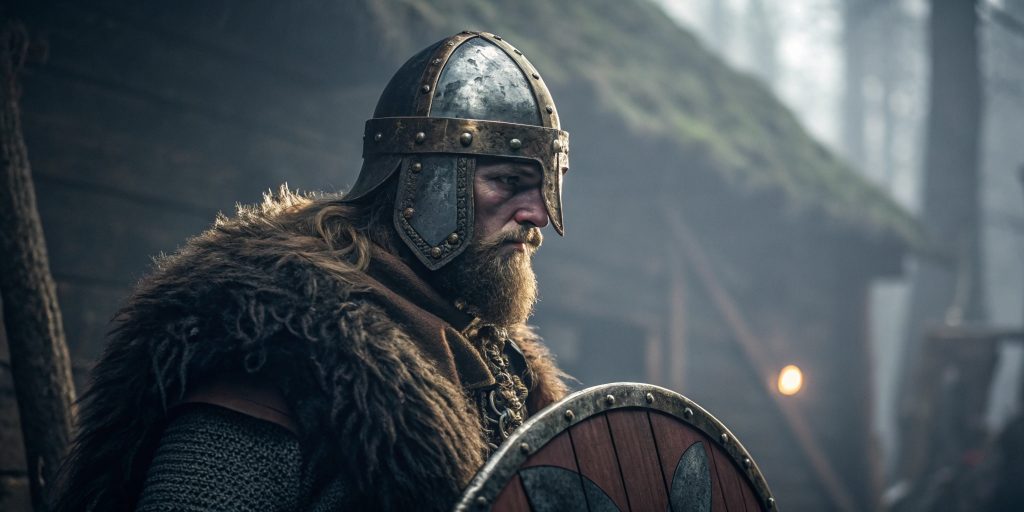Viking Clothing and Jewelry, Viking Weapons and Armor, Vikings
What Did Real Vikings Never Wear?
When we think of the Viking Age, specific images come to mind. We see warriors in rugged armor, sailing longships, and maybe the iconic horned helmet. But these images often come from myths, not facts.
Knowing what real Vikings wore is key to understanding their culture and military. Contrary to what many believe, Viking helmets did not have horns. This myth shows how little we know about their real attire.
We’ll see their significance as we explore the truth about Viking helmets and their clothes, particularly the Viking Gjermundbu helmet. We’ll learn about the practicality of what Vikings wore in everyday life and during battles.
Introduction to Viking Attire
The Vikings wore clothes that were practical and suited their lifestyle. Their clothes were made of wool and linen. These materials kept them warm in the cold Scandinavian climate.
They wore tunics and trousers for comfort and to move quickly. Men wore long tunics that reached their knees, and women wore dresses that reached their ankles, covered by a simple cloak. These clothes let the Vikings show their style through patterns and colors.
- Tunics: Commonly worn by both genders, made from wool or linen.
- Trousers: Essential for mobility, particularly for the working class and warriors.
- Cloaks: These provided additional warmth and versatile styling options.
Viking warriors wore clothes that protected them in battle. They wore heavy tunics, leather vests, and layered clothes, allowing them to move freely while staying safe.
The Myth of the Horned Helmets
The image of a Viking helmet with horns has captured our imagination for centuries. This iconic image is seen in many forms of art and media, making people wonder if Viking helmets had horns.
Exploring the origins of this myth can clear up today’s misconceptions. So, did Viking helmets have horns?
The Origins of the Horned Helmets
The idea of horned headgear with Vikings comes from 19th-century art. Theater and illustrations made Vikings seem to wear horned helmets. These images, though eye-catching, don’t match historical facts.
Common Misconceptions Surrounding Horned Helmets
But there’s no proof that Vikings wore the iconic horned helmet, often depicted in Viking spectacles. Movies and books have made this idea popular, and this myth has become a big part of how we see Vikings.
Knowing the difference between myth and fact is key when discussing Viking clothes.
Real Viking Helmets: What They Looked Like
Viking helmets looked different, showing both practicality and skill. The Gjermundbu helmet is a great example. It shows what made Viking helmets special during the Norse era.
Types of Viking Helmets
Viking warriors wore many helmet types, each with its strengths:
- Nasal helmet: It had a special nose guard for face protection, which is characteristic of the Viking helm design.
- Gjermundbu viking helmet: Known for its rounded shape and strong build, the Viking helm was comfy and safe.
- Spangenhelm: Famous for its segmented design and flexibility.
Materials Used in Viking Helmets
These helmets were made from strong materials:
- Iron: Iron was key because it was strong and easy to find.
- Steel: Used in better helmets, steel made them stronger against swords.
- Leather: Added to metal parts, leather made helmets more comfortable and flexible.
Using these materials made helmets strong and showed Viking metalworkers’ skill. The real Viking helmet shows their battle needs.
What Real Vikings Wore in Battle
Vikings wore helmets for protection in battle, but they had more than just headgear. They also wore armor and gear to stay safe while moving.

This mix of armor and materials helped them stay safe and quick in battle.
Armor and Chainmail
Chainmail was key in Viking armor. It was good against slashing weapons and let warriors move freely. They wore chainmail coifs to protect their heads and necks.
They also had other armor made from leather or cloth. This made them safe without slowing them down.
Other Protective Gear
Shields, made from wood and metal, were important in Viking battles. They helped warriors attack and defend.
Vikings also used bracers and greaves to protect their arms and legs. Their gear showed they were ready for battle.
Everyday Clothing of the Vikings
The Vikings’ daily clothes were key to their lives. They mixed usefulness with social meaning, showing who they were and their status.
Materials Used in Viking Clothing
Wool and linen were the Vikings’ go-to fabrics. Wool kept them warm and lasted long, while linen was used for cooler times.
They were great at weaving. Their textiles were both useful and beautiful.
Common Attire for Norse Warriors
Norse warriors wore tunics, breeches, and cloaks for comfort. Men had long tunics with leather belts. Women wore longer dresses.
In cold weather, they wore thick wool cloaks. Their shoes were simple but strong for rugged paths.
Every Viking’s clothes told a story of their wealth. The rich had fancy clothes, and the poor had simpler ones. Clothes also showed their place in society, like a Viking helm, representing status.
The Functional Design of Viking Helmets
Viking helmets were made for more than just looks. They were designed to protect warriors in battle. The gjermundbu helmet and the spangenhelm show how smart these designs were, particularly the authentic Viking helmet styles.
What Helmets Like the Gjermundbu Reveal
The gjermundbu helmet, made of iron and shaped to protect the head, was found in Norway. It covers the face and has a nasal guard for extra safety.

What About the Spangenhelm?
The spangenhelm is different. Many people used it during the Viking Age. It’s made of metal plates that move with the head. This helmet was good for fighting because it let air in and protected well.
How Helmets Were Used in Viking Society
Helmets were essential in Viking society. They were not just for fighting. They showed who you were and your place in society.
Military Significance of Helmets
Helmets, such as the Viking spectacle helmet worn by chieftains, meant bravery and leadership in Viking battles. They had special designs that showed the warrior’s honor and rank. A good helmet also showed a warrior’s loyalty and protection of their people.
Wearing a unique helmet, like the replica of a Norman helmet, also scared enemies. It was part of the psychological battle, as the helmet instilled fear in their enemies.
Cultural Roles Beyond Warfare
Helmets, such as the Viking helm, were also used in ceremonies and rituals. They showed the importance of tradition and legacy in Viking society. For example, some helmets were used in initiation ceremonies or as gifts to gods.
The different designs and decorations showed a person’s individuality and social status. They marked a warrior’s rank in Viking society.
Depictions of Viking Helmets in Art
Art has long been a window into the past. It gives us valuable insights into Viking helmets and their role in Norse culture. The Bayeux Tapestry is a key example, showing scenes from the Norman Conquest with Viking helmets.
This tapestry highlights the skill in helmet design, especially in the context of the Viking Gjermundbu helmet. It also shows how important these helmets were to Viking culture. Through art, we learn about Viking warfare and society, including the significance of the helmet with aventail.
Analysis of the Bayeux Tapestry
The Bayeux Tapestry shows Viking influence on medieval warfare. It features many helmets and symbols; each figure gives clues about Viking soldiers and their equipment.
The tapestry’s accuracy helps us better understand Viking helmets. While some artistic changes were made, many details are true. Every detail, from helmet shape to decorations, tells us about Viking warriors.
Importance of Art in Understanding Viking Warfare
Art is key to understanding Viking culture. It lets us connect with a rich history of the authentic Viking culture. The Bayeux Tapestry and other artworks show the symbols of Viking helmets in combat.
These artworks help clear up myths about Viking warriors. They show the complex social structures and their role in medieval battles. Studying these depictions teaches us about helmet designs and Viking society.

